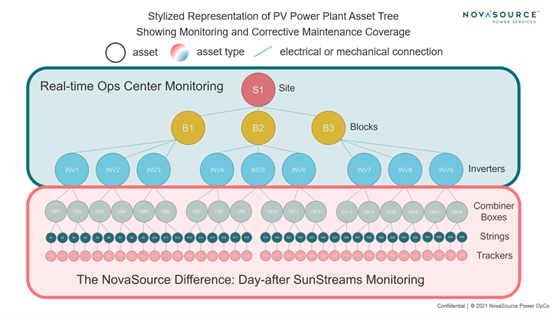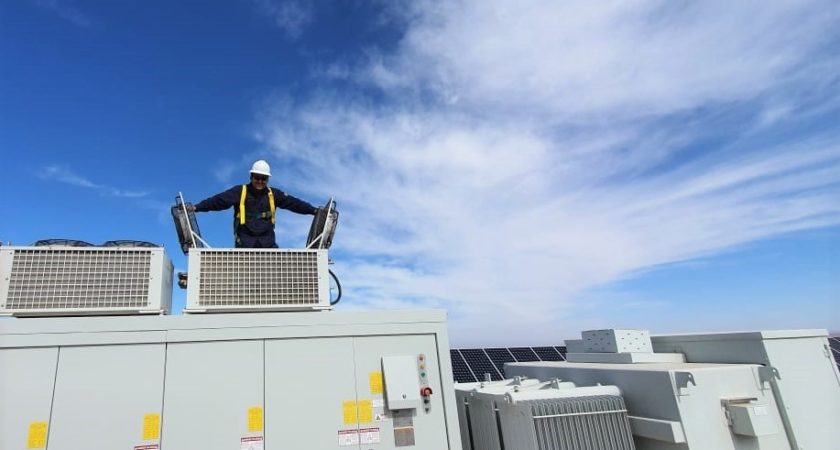
Let’s start with a percentage.
37%
This is a powerful number if you own or operate a 1MW+ solar power plant. Why? The answer has to do with NovaSource’s latest in-house innovation: SunStreams.
SunStreams is a new tech platform that improves your bottom line by remotely and automatically monitoring the performance of the numerous smaller assets (combiner boxes, strings, and trackers) that make up your solar power plant.
This bottom-up approach ensures that every one of these smaller assets is online and operating at peak performance, thereby ensuring that your entire plant is operating at peak performance. It works by identifying and categorizing outliers. This means that SunStreams is very good at ensuring that a well-maintained plant stays well-maintained as new underperformance is detected easily and quickly.
In the case of a plant with a number of existing issues, SunStreams applies a constant upward performance pressure by placing work orders on the worst-performing assets each day. As the largest underperformance issues are fixed, SunStreams begins targeting the smaller issues. Over time, as issues are resolved, the performance distribution of the assets of a plant is pushed upward and tightened: the performance median increases, and the performance variance decreases.

In practice, this can mean that at a given moment in time, although SunStreams has quantified the performance of all assets on a site, SunStreams may not have placed work orders for all existing issues at the site. This approach was employed as it was intended to work well with the staffing approach that NovaSource employs as sites are not generally staffed with enough capacity to address all existing issues simultaneously.
SunStreams is the first platform of its kind and is currently being offered exclusively by NovaSource. If you’re a NovaSource customer or thinking of becoming one, this is good news.
Our fleet data has shown that 1MW+ solar power plants experience an average 0.25% monthly drop of DC capacity due to wear and tear, damage, and/or malfunction of smaller assets such as combiner boxes, strings and trackers. Until recently, the only feasible way to identify these small asset failures was infrared (IR) flyovers. Due to cost, most plants only order one or two flyovers a year.
IR flyovers are complementary to SunStreams use for three reasons:
- IR flyovers can identify module-level defects such as disconnected cells, active bypass diodes, and cracked glass. This is something that SunStreams cannot do.
- IR flyovers provide precise localization to string failures. SunStreams can only localize string failures to the array associated with a particular combiner box. This places the burden of identifying the exact location of a string failure on a technician, which introduces a source of variability.
- IR flyovers provide the opportunity to have work orders placed for all issues found to be existing at a site on the date of the flyover. SunStreams (in its current configuration) places these work orders over a period of time as the worst issues are addressed first and then smaller issues became the worst. For example, work orders for offline combiner boxes would likely be placed first, then work orders for stuck trackers, then work orders for large amounts of DC capacity offline (such as due to a blown fuse in a harness combiner box), then work orders for small amounts of DC offline (such as due to a failed string). In practice, this can mean that work orders for failed strings are never placed if larger issues persist or keep occurring.
IR flyovers remain a very valuable tool and NovaSource plans to continue using them. That’s why SunStreams was designed to support and elevate all other active on-site technologies.
If you own/operate a site that relies on a single solitary annual IR flyover and a string happens to fall offline the day after the flyover, your asset will remain lifeless and undetected for the next 364 days.
Sites that rely on 1 IR flyover/year face an average of 213 days between the date of issue occurrence and resolution. Sites that rely on 2 IR flyovers/year? 122 days. Better, but how does SunStreams stack up?
Sunstreams will detect an issue and have a work order placed within 24 hours. From there, NovaSource technicians will resolve the issue in a median of 15 days.
IR flyovers simply can’t compete with SunStreams’ monitoring of combiner boxes, strings, and trackers unless they fly 365 days a year.
Here are some hard numbers:
In the past 12 months alone, 434 MW of DC capacity has been brought back online under SunStreams stewardship. This 434 MW of DC capacity has an expected energy yield of 871,345 MWh per year which is equivalent to $26,140,350 per year (when energy is valued at $30 / MWh) and is equal to the amount of energy contained in 512,555 barrels of oil.
Did we mention that SunStreams is unique to NovaSource?
Of course, as always, the true magic of NovaSource O&M services rests in the hands of our skilled technicians— they’re the ones making sure your solar power plant is online every time the sun rises, and now, thanks to SunStreams, NovaSource technicians are better equipped to be more efficient than ever.
Speaking of, remember the 37% mentioned up top?
The average extra energy yield that NovaSource customers get from SunStreams is equivalent to 37% of what our full-wrap LTSA (long-term services agreement) services cost (when energy is valued at $30 / MWh). NovaSource offers SunStreams to our customers, at no additional charge, which means NovaSource is essentially rolling out a 37% discount.


